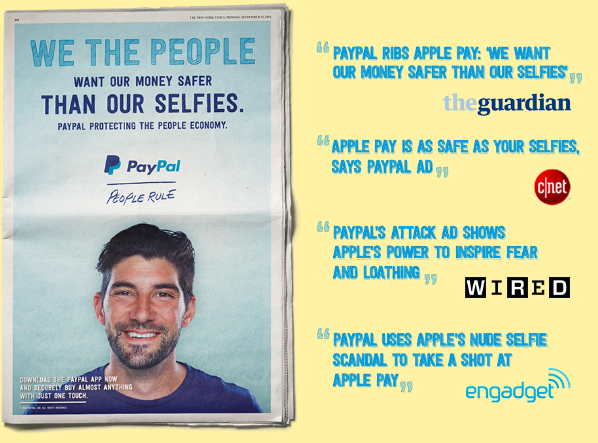Launched in 1998 as Continuity by Ken Howery, Luke Nosek, Max Levchin, Peter Thiel and Elon Musk, Paypal is an online payments system that works as an electronic alternative to conventional transaction methods like money orders and checks. Over the years, the company has operated worldwide as a payment processor for commercial users including online vendors and auction platforms, who benefit from one-click transactions, and seller protection in exchange for a nominal fee.
After PayPal’s IPO was listed at $13 per share that eventually generated more than $61 million, the company was acquired by eBay for $1.5 billion in 2002. By 2017, the company was earning US$13.094 billion in annual revenue (20.8% increase from 2016) and their market valuation was projected to be US$98.2 billion. They were ranked 222nd on the 2018 Fortune 500 of the biggest corporations in the United States.
As of 2019, PayPal is operational in more than 200 countries and have 277 million active, registered users. The company allows customers to send, receive, and retain funds in 25 different currencies.
On the marketing front, the company has invested in TV commercials, social media channels, and outdoor advertising since their inception.
Jeff Goldblum’s ‘OneWayToPay’ campaign:
In 2012, PayPal decided to move on from being known as “just a mobile payment provider” and get people talking about the other advantages their service offers, like, online shopping and in-store transactions.
Paypal’s first-ever nation-wide ‘OneWayToPay’ campaign included four videos featuring Jeff Goldblum who praises the ubiquity and convenience of the platform—from being accepted pretty much anywhere to not requesting for your personal information over and over. “It’s so easy and quick. You do it, you PayPal it, and you’re done,” he says in one of the videos, “You want to move on with your life. You want to have lunch. You want to go take a tango lesson.”
“There’s a lot of consumer awareness of the PayPal brand, but the understanding of all the different ways you can pay with PayPal is something we wanted to focus on,” Anuj Nayar, PayPal’s (former) Senior Director of Global Communications explained on their website,” PayPal is expanding our core product to solve problems for consumers, merchants, developers, and advertisers — not just trying to re-create a wallet that we already invented 14 years ago.”
While the company did not air these commercials on TV, they purchased ad spots on Hulu, AOL, and Yahoo to deliver their marketing message to potential users. The videos were also seen on the several web properties owned by eBay (acquired by PayPal in October 2002).
2014 Holiday campaign with Conan O’Brien and Ellen DeGeneres
In order to bring attention to the speed and security that make PayPal stand out from the crowd, the company partnered with The Many — a California-based agency that’s worked for Hot Wheels, TripAdvisor, and GoFundMe in the past—to create a thoroughly integrated campaign for digital, social and TV.
By collaborating with popular TV show hosts, Ellen and Conan, alongside Collegehumor’s YouTube channels PayPal inserted themselves into conversations about the importance of credit card fraud and identity theft. They lay the basic foundation to launch a large-scale digital campaign that focussed solely on PayPal’s online security.
Overall, the entire campaign resulted in an increased total payment volume—27 percent from the previous year.
During the same year, Apple also unveiled their digital wallet and mobile payment service—Apple Pay, establishing themselves as direct competitors of PayPal. Soon after, when the technology conglomerate was under fire following the iCloud Hacking scandal, PayPal issued a full-page takeover in The New York Times taking a shot at Apple and introducing their new One Touch App functionality.
Let’s enjoy our money, not worry about it. #paypalit for a safer and more secure way to pay: http://t.co/DFAH3bqniS. pic.twitter.com/e5udR8zGBJ
— PayPal (@PayPal) September 15, 2014
They also released a series of innovative co-marketing activations with Munchery and StubHub, sending an extremely clear message in the process: “PayPal is the brand of the People Economy, and with the One Touch App, that economy is easier and faster to tap into than ever before.”

In a social campaign called ‘Epic Experience Time’, PayPal compiled seven real-life experiences with famous influencers (a mini-golf session with Olympic hockey player Hillary Knight or fishing with Shark Tank’s Daymond John) that the users could bid on eBay. In order to increase the reach of the campaign, the company also teamed up with Vine star Avery Monsen to create a 7-second teaser for every experience. The auction proceeds went to a charity picked by the influencer.
PayPal’s decision to promote experiences than products was based on giving millennials what actually matters to them.
“Millennials are all about streamlining their lives,” said Maude Standish, Director of Strategy at The Many. “For example, they don’t want a million books; they want the experience of reading the book on their kindle. They don’t want to own records, they want to own the experience of listening to music.”
At one point, an exclusive yoga class for you and your dog was going for $1,225, whereas the bid for fishing with Daymond John was at a whopping $3,400.
‘New Money’ campaign
In 2016, the company introduced the New Money campaign that aimed to simultaneously make a strong statement about the future of money and unveil the new PayPal to the masses. Targeting millennials in Singapore and Asia Pacific specifically, the marketing initiative started off with a 45-second commercial that highlighted the endless possibilities of a paperless payment method that’s not limited by geographical factors or time zones. “New Money has no boundaries,” explained Leanne Sheraton, PayPal’s head of APAC marketing & consumer business, “We have the technology, the innovation for people to be able to buy and sell securely and confidently no matter where in the world they are. These are the possibilities of the new global economy.”
The commercial features quick cuts, and tosses light-hearted insults at the “old money” that are represented by banks closing at 5 p.m, green lampshades, glimpses of suspenders—and everything else that ‘new money’ aims at changing.
The commercial first aired during the annual SuperBowl was produced by Nabil Elderkin, who’s highly-renowned for his work with popular music artists like Kanye West and Nicki Minaj.
As PayPal moves forward and aims to completely transform how an average person navigates the complexities of a global economy, their overall advertising strategy continues to be a deciding factor in their long-term success.
Let’s take a closer look at their current advertising strategy:
Ad Spend and Ad Networks
In the last six months, PayPal has spent $20.4M on online advertising, out of which, the majority went towards Google ($15.2M), Direct Buy ($4.4M) and Google Native ($548.1K).

Google allows you to connect with prospective customers when their most recent online activity (searching for a specific product/service that you provide or reading an article about the industry you operate in) is directly related to what your brand has to offer. When your ads appear in relevant places, you’re in a better position to convert interested viewers into long-time customers.
The Google Network is classified into broad groups, so brands have more control over the placement of their ads:
- The Search Network that includes the Google search results pages, other Google assets like Maps and Shopping, and search platforms that have partnered with Google to show ads. The biggest intrinsic advantage of using the search network is that you can spend your bid on “high-intent” keywords, ensuring that your text ads will be served to users who have the purchasing power and willingness to convert.
- The Display Network that includes Google-owned platforms like Gmail, YouTube, and Blogger, in addition to the thousands of Google-partner websites on the Internet. Unlike the search network, your ads are consumed mostly by passive customers who’re not actively looking for a solution to their pain points. As a result, the display network is perfect for brands that want to invest in top-of-funnel brand awareness.
Considering that PayPal relies heavily on image-based (or display) ads, we can safely assume that they’re rather keen on telling more and more people about their brand, as opposed to getting higher click-through-rates (CTRs) and conversions. This also explains why they also invest just as much (if not more) money in desktop advertising than mobile. According to Yahoo! Research, omnichannel advertising increases brand engagement and “stimulates disengaged consumers to transition to engaged stages”. However, it does not persuade an already interested consumer, thereby, making it more effective for the early impressions and not the late ones.”
By coordinating their online campaigns with the ones running on TV, PayPal has been able to encourage customers to pursue their preliminary interest in the product and ultimately, make the eventual purchase.
In a surprising, yet, pleasant twist, 76 percent of PayPal’s ads are programmatic, which means they use real-time bidding to deliver deeply relevant, measurable, and compelling ads. Additionally, 22 percent of their ads are Direct, and only 3 percent are native.
Publishers
PayPal’s primary publishers have remained the same over the past year, with most of their ad spend going to SpanishDict ($1M), Merriam Webster ($444.9K), Dictionary.com ($315.1K), and Wikihow ($303.3K). Buzzfeed ($306K) has been a new addition to the top five tally in the last 6 months, replacing eBay (PayPal’s former parent company that they separated form in 2018).
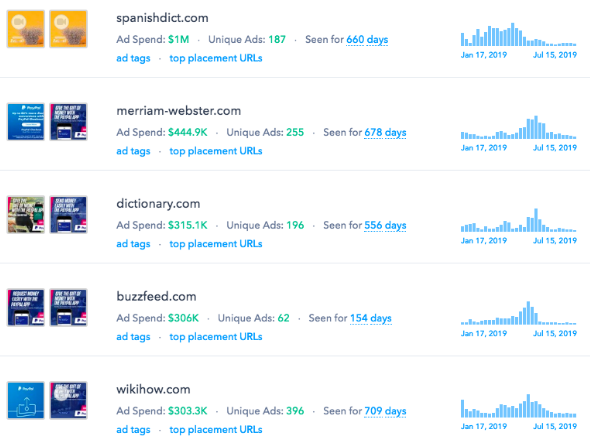
As for the placement, PayPal’s ads don’t follow a fixed pattern—which means that they appear on arbitrary landing pages that have nothing to do with their product/service. For example, on Dictionary.com, the ads were shown to people looking up the meaning of sacrilege, refugee capital, invent, and forfeit among others. Similarly, on Buzzfeed, the ads can be found on articles about cats, life hacks, guacamole recipe, star wars, portable battery packs and more.
One can assume that these pages are either expected to get a lot of organic attention or are promoted well and often by the publishers.
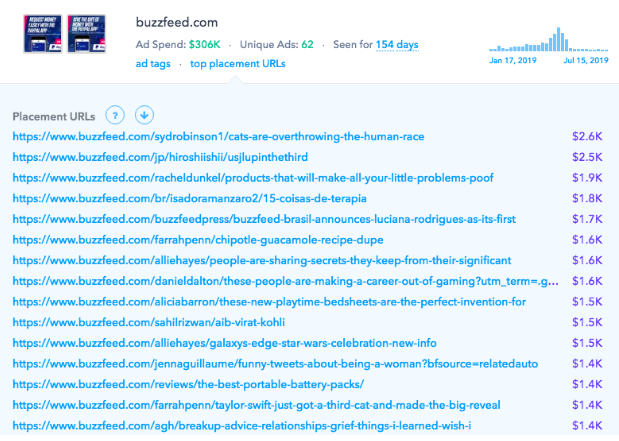
Overall, we can conclude that PayPal has been actively advertising with publishers that get a significant amount of traction every month to ensure that their ads are shown to as many people as possible. They’re not concerned about reaching the right people by using any targeting parameters like a lot of other brands—and that continues to work in their favor.
Creatives
PayPal has a very diverse portfolio of ads that includes 69 percent images, 18 percent HTML5, 7 percent video, 6 percent text/image and less than 1 percent text-based.
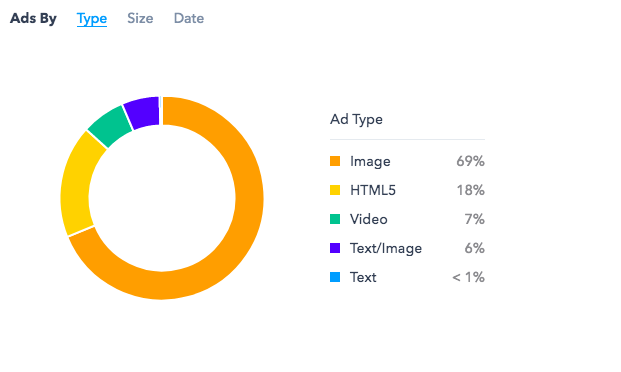
In the following ad that targets businesses and merchants, PayPal introduces their B2B customers to their easy checkout feature that makes it easy for buyers to make a payment without leaving the website.
The copy is short, data-driven and directly speaks to the audience.
Numbers add weight to a benefit statement, which in this case, happens to highlight how PayPal Checkout can increase conversions for merchants. Not to mention, customers find percentages easier and faster to read when they’re written with % versus the word percent.
The call to action (CTA) —”Learn more”—is critical to the display ad, because it not only encourages the viewer to take action, but also helps set expectations for what they’re about to see next. On a related note, sometimes, prospects don’t want to be greeted with hard-sell CTAs like Buy Now or Sign Up right away, therefore, going with other helpful and more welcoming alternatives might be a better idea.
Alternatively, for their B2C customers, PayPal’s campaigns were aimed to normalize the act the sending payments to your family, friends, co-workers and other personal acquaintances.
While the short, straightforward tagline of ‘Give the gift of money’ stays the same across multiple creatives, the scenarios — what you’re making the payment for — continue to change. For example, in one creative, the payment is being made ‘for dinner’ but in the other, it’s being made ‘for wedding’.
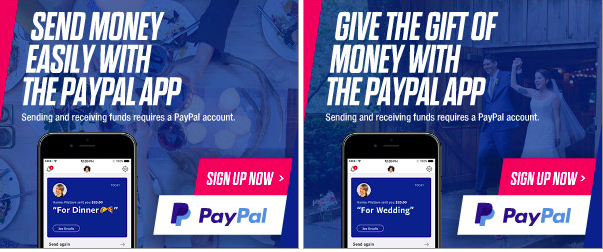
For their video campaigns, they partnered with the NYC-based agency, Walrus, to come up with fact-based, quirky character animations to illustrate how big of a number 19 million (number of online stores using PayPal) actually is. The 15-second video opens in a clinical “infographical” way with an overly serious voiceover and uses a bar graph with the PayPal logo on top.
Since these are meant for both web and social networks, the videos were rendered at 2500 x 2500 pixels, so they can be easily re-positioned for any aspect ratio. In the long-run, this not only saves time, but also keeps file sizes manageable.
Overall, the videos are a fun and inventive way of communicating why a business should use PayPal by establishing how many happy customers PayPal actually has. What’s notable is that they started investing in video campaigns like these only in the last 6 months — and considering that a generous amount of their ad spend is going towards these ads, we can assume that the company has received favorable results.
Landing Pages
Most of the PayPal ads direct customers (whether B2B or B2C) to a landing page dedicated to the USP mentioned in the ad. For example, there are specific pages for ‘send money online’, ‘use PayPal Checkout to increase conversions’, and ‘ create an invoice with ease’ that go into more detail about a person can benefit from a specific functionality that PayPal offers.
Overall, all landing pages open with simple, yet, relevant imagery. In the first scroll, you can see a straightforward, user-centric headline and description about the specific value proposition of the feature — for example, “sell more online”, and “make it easy for shoppers to pay the way they want” on the PayPal Checkout page). Remember, value creates desire, which ultimately, leads to a higher number of conversions.

By using two conversion paths—”See how it works” and “Sign Up”—the company is able to address two different types of customers in their sales funnel: those who’ve already made a decision to convert, and those who prefer having a little more information on hand before they make up their mind. Another interesting element here is how PayPal uses strategically uses colour to draw users closer to the conversion event. The ‘Sign Up’ button has a different colour scheme than the entire background of the page—while on blue or blue on neutral—making it stand out from the rest of the design.
When you scroll further, you’ll find that the landing page addresses specific customer concerns to alleviate worry, reassure visitors, and build trust. For example, on the page about ‘Send Money Online’, PayPal answers potential questions related to security, transaction fees, mobility, and access.
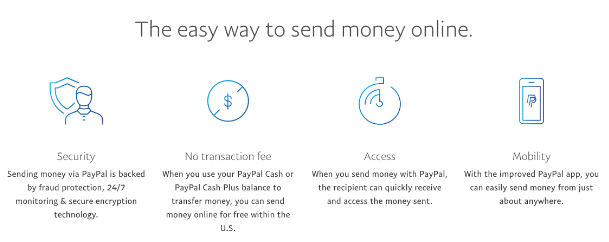
Overall, the information on the landing page is detailed—but well packaged, which persuades people to keep on reading further, instead of leaving after the first scroll.
Conclusion
Unlike most brands that spend their money on only a particular ad-type that’s worked for them—native, programmatic, video, or direct—PayPal continues to remain diverse and has been experimenting with everything to see what sticks. They seem to be focusing more on perfecting the grassroots-level stuff, like, creatives, landing pages, channels, and ad formats that work the best for a certain ad-type. In some cases, they’ve discovered the exact elements that make for a successful campaign—their publishers, for example, that haven’t changed in the past year, however, they’re still trying a lot of new things on the side, like, their video ad campaigns that appeared on the internet radar only six months ago.
In short, PayPal has figured out a lot about the advertising approaches that work for them, but that’s not stopping them as they continue to refine their overall strategy, and try new ways to engage with customers.
